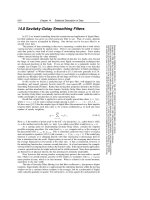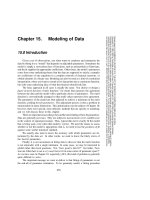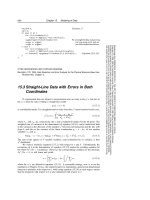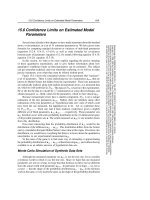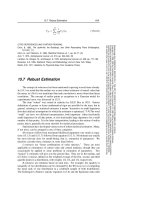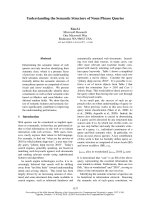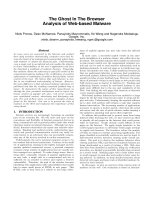THE FRACTAL STRUCTURE OF DATA REFERENCE- P24 ppt
Bạn đang xem bản rút gọn của tài liệu. Xem và tải ngay bản đầy đủ của tài liệu tại đây (117.64 KB, 5 trang )
Hierarchical Storage Management 105
level 0 to level 1, and both levels use the same type of disk hardware, then the
cost of level 1 storage would be one
-
half that of level 0.
Although we wish to determine the amount of primary disk storage by
modeling, it is also desirable to ensure some minimum amount of primary
storage. Even if the storage management policy specifies the fastest possible
migration (migration after 0 days), some primary storage will still be needed
for data currently in use, for free space, and as a buffer for data being migrated
or recalled. The model allows this minimum storage to be specified as a fixed
requirement.
Our storage management model therefore ends up using the following vari
-
ables:
minimum primary storage (gigabytes).
primary storage beyond the minimum (gigabytes).
level 1 disk storage (gigabytes).
s
0
+ s
1
= total disk storage beyond the minimum (gigabytes).
cost of primary storage ($ per gigabyte per day).
cost of level 1 storage, after accounting for compression ($ per gigabyte
per day, E
1
< E
0
).
recall delay due to miss in level 0 = time to recall from level 1 (seconds).
recall delay due to miss in level 1 = time to recall from level 2 (seconds,
D
1
> D
0
).
level 0 miss probability per
I/O (probability that the requested data is
not at level 0).
level 1 miss probability per
I/O (probability that the requested data is
neither at level 0 nor level 1).
target delay per
I/O (seconds).
migration age (period of non
-
use) before migrating data from level 0
to level 1 (days).
migration age (period of non
-
use) before migrating data from level 1
to level 2 (days τ
1
< τ
0
).
In terms of these variables, we wish to accomplish the following
Constrained optimization version A: Find the two values s
d
≥ s
0
> 0,
such that
106
is a minimum, subject to:
THE FRACTAL STRUCTURE OF DATA REFERENCE
Constrained optimization version A is not yet ready, however, to apply in
practice. First, we must quantify how the level 0 and level 1 miss ratios m
0
and
m
1
relate to the corresponding amounts of storage s
0
and s
d
.
To keep terminology simple, let us focus on the recalls that must go beyond
some specific level of the hierarchy in order to service an
I/O request, while
lumping together all of the storage that exists at this level or higher. Let m be
the probability that a recall will be needed that goes outside of the identified
collection of levels, which occupy a total amount of storage s beyond the
minimum. Thus, m and s may correspond to m
0
and s0, or may correspond
to m
1
and s
d
, depending upon the specific collection of levels that we wish to
examine.
Now, some of the storage referred to by s will be occupied by data that has
arrived there via recall and will leave via migration. Let this storage be called
s
cycle
, and let remaining storage (occupied primarily by files not yet migrated,
and also by data that is in between being recalled and being scratched) be
called s
other
. Since the files in either component of storage can stay longer as
the migration age increases, we should expect that both of these components
of overall storage should increase or decrease with migration age. In hopes
of getting a usable model, let us therefore try assuming that these two storage
components are directly proportional to each other; or equivalently, s
cycle
= k
1
s,
for some constant k
1
.
Since the data accounted for by s
cycle
enters the corresponding area of storage
via recall and leaves via migration, the behavior of this subset of storage is
directly analogous to that of a storage control cache, in which tracks enter via
staging and leave via demotion. It is therefore possible to apply the hierarchical
reuse model, as previously developed in Chapter 1. By (1.23), this model
predicts that
for some constants k
2
and θ. If we now substitute for s
cycle
, we are lead to the
hypothesis that, for constants k and θ which depend upon the workload, the
estimate
(8.1)
(8.2)
may provide a viable approximation form.
It is important to emphasize that there is no reason to believe that s
cycle
and
s
other
are precisely proportional; thus, the equation (8.2) obtained from this
assumption is merely a mathematically tractable approximation that we hope
may be “in the ballpark”. The underlying hierarchical reuse model does offer
Hierarchical Storage Management 107
one important advantage, however, in that it predicts significant probabilities of
needing to recall even very old data. This behavior differs, for example, from
that which would result from assuming an exponential distribution of times
between requests [38]. The need to recall even years
-
old files is, unfortunately,
all too common (for example, spreadsheets and word processors must retain
the ability to read data from multiple earlier release levels).
It should also be recalled, by (1.4), that m is directly proportional to τ
−θ
,
where τ is the threshold age for migration. Thus, the calibration of θ at a
specific installation can be performed if data are available that show the recall
rates corresponding to at least two migration ages.
For example, at the installation of the case study reported in the following
section, simulations were performed to obtain the recalls per
I/O at a range of
migration ages. These were plotted on a log/log plot, and fitted to a straight
line. The estimate θ = 0.4 was then obtained as the approximate absolute
slope of the straight line.
At an installation where hierarchical storage management is in routine use,
HSM recall statistics will include the recall rates corresponding to two specific
migration ages (those actually in use for level 0 and level 1 migration). Based
on these statistics, the value of θ can be estimated as:
Once a calibrated value of θ has been obtained, the value of k can be
estimated as:
(other, more simple methods of calibrating k are also practical, but the formula
just given has the advantage that it can be applied even without knowing s
00
).
At the installation of the case study, the estimate k = .000025 was obtained.
While on the subject of calibration, the parameter s
00
should also be dis
-
cussed. In the installation of the case study, this parameter was estimated as
the primary storage requirement when simulating a migration age of 0 days
(14.2 gigabytes). However, it is also possible to “back out” an estimate of this
quantity from the statistics available at a running installation. For this purpose,
let s
prim
be the total primary disk storage (that is, s
prim
= s
00
+ s
0
). By again
taking advantage of the recall rates corresponding to the existing migration
policies, we can estimate that:
108 THE FRACTAL STRUCTURE OF DATA REFERENCE
For the sake of modeling simplicity, it is also possible to assume s
00
= 0. In
this case, some amount of extra primary storage should be added back later, as
a “fudge factor”.
By taking advantage of (8.2) to substitute for m
0
and m
1
, we can now put
constrained optimization version A into a practical form. At the same time,
we also drop the fixed term E
0
s
00
(since it does not affect the selection of the
minimum cost point), and rearrange slightly. This yields
Constrained optimization version B: Find the two values s
d
≥ s
0
≥ 0,
such that
is a minimum, subject to:
This minimization problem is easily solved, using the method of Lagrange
multipliers, to determine the best values of s
0
and s
d
corresponding to a given
set of costs and recall delays. The minimal cost occurs when:
(8.3)
This is the most interesting result of the model, since it expresses, in a simple
form, how the role of primary storage depends upon storage costs and access
delays.
For completeness, the remaining unknowns of the model can now be obtained
by plugging the ratio given by (8.3) into the original problem statement:
(8.4)
Returning to (8.3), this equation reflects an interesting symmetry between
the impact of relative storage cost (E
0
versus E
1
) and that of relative miss delay
(D
0
versus D
1
). In practice, however, the latter will tend to drive the behavior
of the equation. For example, if we plug in values taken from the case study
reported in the following section, (8.3) yields:
Hierarchical Storage Management 109
(8.5)
In this calculation, the compression of level 1 storage yields a two
-
to
-
one
advantage in storage costs compared to level 0. This causes the factor E
1
/ (E
0
–
E
1
) to equal unity. As this example illustrates, values not much different from
E
1
/ (E
0
– E
1
) = 1 are likely when level 1 and level 0 use the same type of disk
device.
By contrast, the factor D
0
/ (D
1
– D
0
), which reflects the comparisonofmiss
delays at level 0 relative to miss delays at level 1, will tend to be much less than
unity. Typically, D
0
will reflect the time to copy and decompress data from disk
(assumed above to be 16.2 seconds), while D
1
will reflect the time to complete
a copy from some form of tape storage (assumed above to be 90 seconds, due
to the planned use of robotics). A disparity in delay times of this order will
lead to relatively light use of primary storage (in the case of the assumptions
just stated, the value s
0
/ s
d
= 0.402 as shown by (8.5)). This arrangement
takes optimum advantage of compression to avoid tape delays. The greater the
disparity in miss delays, the smaller will be the optimum percentage of level 0
disk storage. Conversely, if tape delays are reduced by tape robotics or other
technology, then (8.3) indicates that there should be a corresponding increase
in the use of primary storage.
Note that the result s
0
/s
d
= 0.402, as just calculated above, is a statement
about logical storage. To obtain the corresponding statement about physical
storage, we must examine the quantity
(8.6)
where C is the level 1 compression ratio. Thus, given the assumptions just
discussed in the previous paragraph, the physical ratio of primary to overall
disk storage (neglecting the minimum primary requirement) should be [1 –
.5 + .5/.402]
-1
= .573.
To finish our example, we can apply (8.4), coupled with the objective D =
.136 milliseconds, based upon matching current delays, to obtain:
